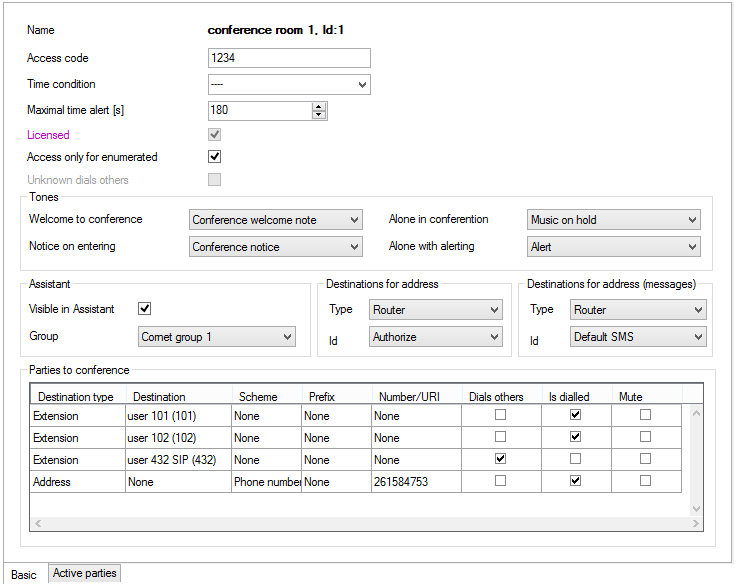6.7 Conference Rooms
For conference room settings refer to the Global data – Conference rooms menu. Use this menu to configure the conference rooms and define the authorised users. This function is subject to licence, so make sure that you have the required count of licences for operating all of your conference rooms.
Basic
- Access code – is used for distinguishing your conference rooms within the service. Therefore, assign a unique access code to each conference room.
- Time condition – define a time interval to limit the conference room use. If no time condition is defined (– – –), the conference room is accessible continuously.
- Maximum time alert [s] – define the maximum ringing time for each of the extensions called together within a conference room. After this time interval, ringing to unanswered extensions is terminated. The default value is 180s.
- Licensed – if this checkbox is ticked off, the conference room is licensed and may be used. If not, check the count of licences in the Global data – Licences menu and purchase new licences or delete unused conference rooms as necessary.
- Access only for enumerated – lock the conference room and give access to selected users only. Unauthorised users are denied access to the conference room.
- Unknown dials others – assign the conference-calling right to a user that is not included in the conference room.
Figure: Conference Room Settings
Tones
- Welcome to conference – this tone is played to the user after the user's joining the conference called by the selected conference room (handset pick-up).
- Notice on entering – this tone is played to the conference participants after joining of the user that was not dialled during the conference calling or got out of the conference and is now trying to rejoin the conference room.
- Alone in conference – this tone is played to the user that remains alone in the conference room (no other extension is even ringing).
- Alone with alerted – this tone is played to the user that is the first or only to answer during ringing to the conference room users. As soon as another user answers the phone, the tone is disconnected.
Assistant
- Visible in Assistant – enable displaying of the particular conference room in the Assistant.
- Group – with the Assistant display enabled, specify here the user group for which the conference room should be visible. To make it visible for all user groups, select (– – –).
Destination for addresses
Use this parameter to define the routing destination if the address specified in the Conference subscribers block is used for conference call set-up. If the Default destination type is selected and the calling party is an address, you cannot call the specified addresses but can call the extensions and users that are dialled directly. If the calling party is a extension or user, you can call the addresses too (routing From port of the calling party is used).
- Type – define the destination type for the address.
- Id – define the specific destination of the selected type.
Destination for addresses (messages)
Set the destination for routing bulk SMS messages if sent to the address specified in the Parties to conference. The SMS can only be sent to the parties to the conference from the Assistant web application. A user may send an SMS on condition that the user is assigned the conference room rights in the Assistant and the conference room is visible in the Assistant.
- Type – define the destination type for the address.
- Id – define the specific destination of the selected type.
Parties to conference
In this configuration section, you can specify users, extensions or just telephone numbers including properties for a conference room. For this purpose, seven columns with the following meanings are available:
- Destination type – select a user, extension or address. The following columns are available or not depending on your selection.
- Destination – define a extension or user.
- Schema – enter the Number or URI scheme for the address.
- Prefix – select the required prefix from the list of prefixes defined in the Global data – Global parameters menu for the address. Use this prefix for dialling the given conference subscriber.
- Number/URI – enter a specific Number of URI for the address.
- Dials others – set whether the selected user has the right to call a conference for the selected conference room.
- Is dialled – set whether the selected user shall be dialled or not during conference set-up.
- Mute – set only listening-in for the user. The other parties to the conference do not hear the user.
- Destroy when created – enable the right to terminate a conference for the user that called the conference or was the first to call the conference room.
Active users
This tab includes an on-line list of all active conference participants. The extension name (if available in the telephone directory), scheme (Number/URI), number type (national, internal, ...) and the number are defined here for each of them. You can mute/unmute each user in the Mute column. Such setting is applicable until the next change or call end.

